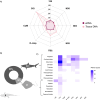Rapid DNA/eDNA-Based ID Tools for Improved Chondrichthyan Monitoring and Management
- PMID: 40970298
- PMCID: PMC12550492
- DOI: 10.1111/1755-0998.70044
Rapid DNA/eDNA-Based ID Tools for Improved Chondrichthyan Monitoring and Management
Abstract
Rapid DNA/eDNA-based ID tools, which detect specific genetic patterns without requiring sequencing, are essential for biodiversity and wildlife trade monitoring, particularly for species of conservation concern. However, the practical application of these methods remains limited by the availability of standardised protocols, accessibility of resources, and coverage across diverse taxa. This challenge is especially pronounced for Chondrichthyes, a group heavily overexploited due to fishing and illegal trade, and with data scarcity for conservation assessments. Despite their ecological and economic importance, many species lack reference sequences in databases, as well as other molecular data and tools, hindering the development of molecular tools for species identification and trade regulation. This review synthesises the current state of rapid DNA/eDNA-based ID tools for the detection of chondrichthyan species, including established and emerging methods. It also compiles available taxon-specific primers to facilitate efficient species identification and recommends the most suitable methods. We identify key gaps in taxonomic and geographic coverage, emphasising the need for further research to expand these tools to under-represented species and regions. Additionally, we highlight the importance of integrating genetic approaches into enforcement frameworks to enhance conservation strategies and regulatory compliance. By providing an accessible reference for time- and cost-effective genetic monitoring, this work will support evidence-based decision-making and improve the practical application of rapid DNA/eDNA-based ID tools in the conservation and management of Chondrichthyes species worldwide.
Keywords: LAMP; Multiplex PCR; conservation genetics; ddPCR; elasmobranch; environmental DNA; fisheries management; qPCR; sharks and rays; species identification.
© 2025 The Author(s). Molecular Ecology Resources published by John Wiley & Sons Ltd.
Conflict of interest statement
The authors declare no conflicts of interest.
Figures


References
-
- Abdi, G. , Singh S., Selvakumar S., et al. 2024. “DNA Barcoding and Its Applications.” In Advances in Genomics: Methods and Applications, 91–117. Springer.
-
- Abercrombie, D. L. , Clarke S. C., and Shivji M. S.. 2005. “Global‐Scale Genetic Identification of Hammerhead Sharks: Application to Assessment of the International Fin Trade and Law Enforcement.” Conservation Genetics 6, no. 5: 775–788. 10.1007/s10592-005-9036-2. - DOI
-
- Aguilar‐Rendón, T. A. , Rendón‐Herrera J. J., Osuna‐González V., González E. C. O., Domínguez‐Domínguez O., and Saavedra‐Sotelo N. C.. 2020. “Molecular Identification of Hammerhead Shark Trunks From the Southern Gulf of California Using Multiplex PCR.” Journal of Fisheries Science 2, no. 1: 22–29. 10.30564/jfsr.v2i1.1685. - DOI
-
- Akhilesh, K. V. , Kizhakudan S. J., Muktha M., et al. 2023. “Elasmobranch Conservation, Challenges and Management Strategy in India: Recommendations From a National Consultative Meeting.” Current Science 124, no. 3: 292–303. 10.18520/cs/v124/i3/292-303. - DOI
-
- Albonetti, L. , Maiello G., Cariani A., et al. 2023. “DNA Metabarcoding of Trawling Bycatch Reveals Diversity and Distribution Patterns of Sharks and Rays in the Central Tyrrhenian Sea.” ICES Journal of Marine Science 80, no. 4: 664–674. 10.1093/icesjms/fsad022. - DOI
Publication types
MeSH terms
Substances
Grants and funding
- The University of Texas at Austin Marine Science Institute (UTMSI)
- PVS-0215-00123.02.00/23/Fundação Cearense de Apoio ao Desenvolvimento Científico e Tecnológico
- SOSF 588/Save Our Seas Foundation
- Coordenação de Aperfeiçoamento de Pessoal de Nível Superior
- 2021.05642.BD/Fundação de Ciência e Tecnologia (FCT), Portugal
LinkOut - more resources
Full Text Sources

